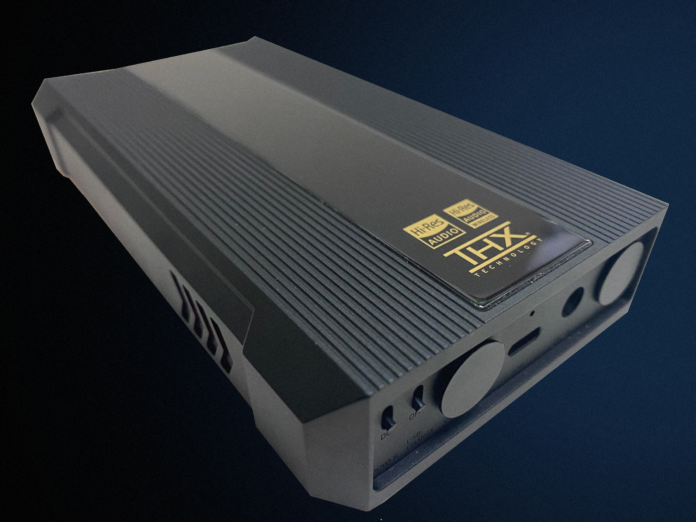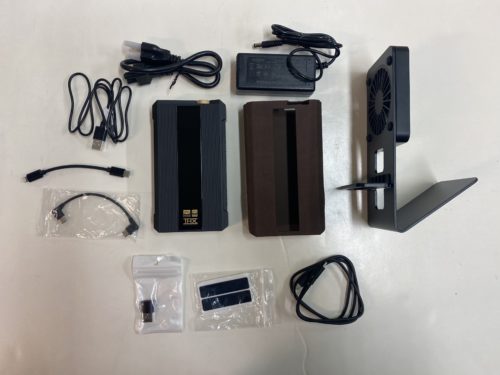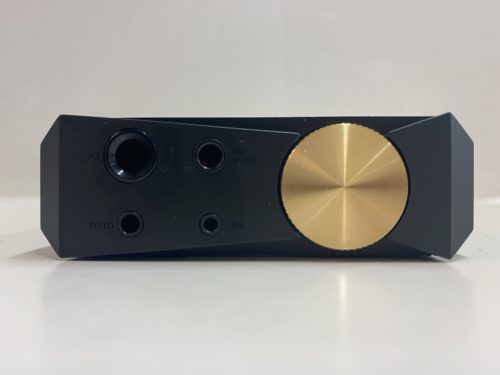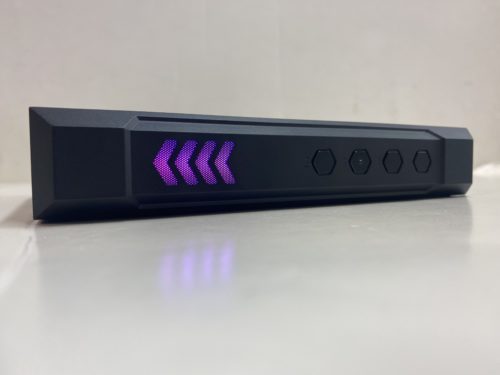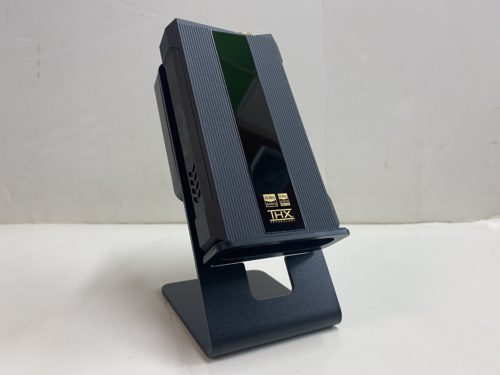Ever since listening to the Fiio M17, I have been craving a similar system to match its class. It is still one of the most powerful DAPs you can have, bringing you a desktop-level experience portably. Fiio has now released the Q7, which aims to deliver that experience yet again, but this time with a potable DAC/Amp in line with the Chord Mojo 2 and iFi Gryphon. Is the Q7 the same as the M17 just as a standard portable DAC/Amp?
What You Get
- Q7 x1
- Leatherette case x1
- Cooling stand x1
- USB power cable x1
- Power adapter x1
- AC power cord x1
- USB adapter x1
- TypeC to TypeC data cable (long) x1
- TypeC to TypeC data cable (short) x1
- Lightning to Type C cable x1
- Quick start guide x1
- Warranty card x1
Build
If the Q7 has any similarities to the M17, it’s its build. It is as if the M17 was built without its Android OS and touch screen. The Q7 is a brick of a device, with every facet of its design meant to give you an impression of its potential power. Its aesthetically pleasing color display is also carried over from the M17, presenting the Q7 with the same level of prestige. You also have the same number of headphone slots too, with the Q7 supporting headphones with quarter-inch, 4.4mm, 2.5mm, and 3.5mm jacks. Its volume dial is also similar but it clicks in to activate different options on the device’s LED screen. On the bottom of the device is a UBC Type C connector for data transfer and charging, DC power, and optical/coaxial inputs.
Design
The interiors of this system boast all the components that make the Q7 a desktop-class amplifier. One of the main features of the Q7 is its integration of the THX AAA788+ amplifier. With this circuitry, the Q7 aims to deliver a massive output to drive any power-hungry headphones with ultra-low noise. A high-end desktop DAC/Amp needs to have the right chipset too, and the Q7 comes packed with an ES9038PRO DAC. It has 4 channels connected in parallel in order to extend resolution capabilities. This is combined with a 16-core XMOS XU316 chip which has the responsibility of decoding full MQA. It also supports DSD512, ultra-low latency, and sample rates up to 768kHz. To just add to the Q7’s prowess, you also get Bluetooth. A third chip in the form of a Qualcomm QCC5124 chipset, offering Bluetooth 5.0 and a series of CODECs that include LDAC and aptX LL.
Sound Impressions
There are many variations of sonic potential happening when you use the Q7. Factors like gain settings, battery mode, filters, and output settings will all determine the quality of your listening experience. As someone who adored the sound signature of the M17, I had a lot of expectations going into the Q7. My initial thoughts on its sound are a lot more complicated than I had imagined. I think when testing IEMs, the Q7 is an absolute monster of a system. In high and super high gain mode, you will make more than the most out of your IEMs, no matter what their sensitivity and impedance are.
The Q7 is able to push the sound of IEMs forward, and expand their output without any signs of distortion. However, on super-high gain, you can clearly hear the noise floor. I picked up on this when testing the Kadence from Noble Audio, letting me know right away how powerful the Q7 is going to perform with them. While the Q7 pairs excellently with most IEMs, I found a number of headphones only just get there in terms of power.
My first minor issue was when listening to the Dan Clark Audio Expanse. The headphones were powered well, but the gain was always close to max even on super-high gain. I would have liked more headroom here for a desktop-class amplifier. However, listening to the Q7 do its thing is still a fulfilling experience. The way it enlarges the size of the imaging brings even more immersion to the soundstage. Individual performances are cleaner and highlighted in the mix, with even more spatial definitions to engross yourself in.
I felt a similar way about testing the Q7 with the Sennheiser HD800s. Its drive only just got there towards the top end of max volume, but the actual timbre at that level still brings great results. The Q7 is able to break the HD800s out of their linearity and deepen the soundstage. They seemed less flat, pushing the music more vertically than before. Instruments and vocals are taller, and it never minimizes the awesome width the 800s already possess. So minus some underwhelming amplitude with particular power-hungry headphones, the sound signature always delivers.
Summary
The Fiio Q7 does its job of being a portable desktop DAC/Amp, even if some of its power isn’t quite up to par. I’m looking forward to testing it out more with different headphones and IEMs, but for now, I don’t think it reaches the level of the M17. With its cost being much less than that unit, this isn’t so much of a dealbreaker, as the Q7 boasts a good amount of power for its range. With all of its input options, the Q7 can have a ton of uses as a portable system.
| Pros | Cons |
|
|
The Fiio Q7 is available at Audio46.
MAJORHIFI may receive commissions from retail offers.


